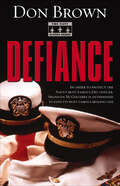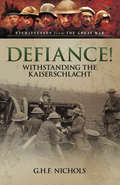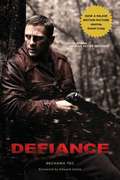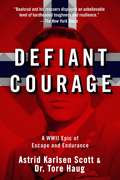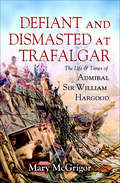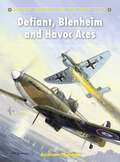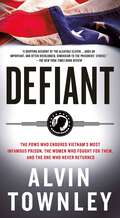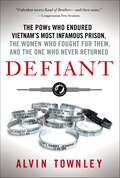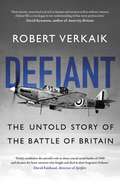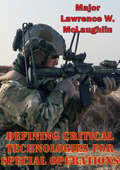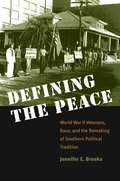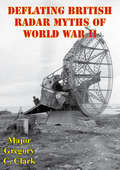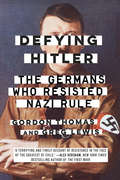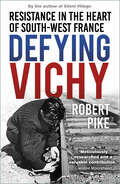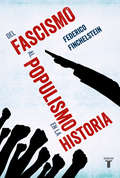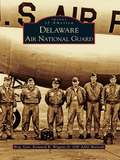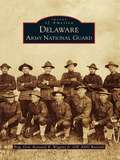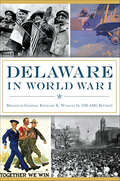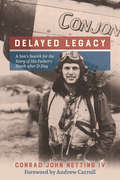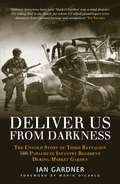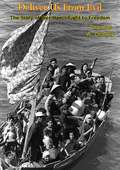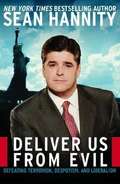- Table View
- List View
Defiance (The Navy Justice Series #3)
by Don BrownFrom a murder in Paris to a courtroom in California to a terrorist camp in the Gobi Desert, Don Brown’s follow-up to Treason and Hostage plunges into a suspense-filled journey of danger, duty, and hope. The Commander’s Bodyguard is Shannon McGilverry, a crack NCIS agent assigned to protect Navy JAG Officer Zack Brewer. Zack is being hunted by terrorists, stalked by a psychopath, and is working his way through a perilous, politically-charged trial. When another Navy JAG officer is murdered, it’s clear that Zack is in harm’s way. As his bodyguard, Shannon must do more than protect Zack. She also must set aside her growing feelings for the brilliant attorney and investigate rumors that the love of his life, Diane Colcerninan, may still be alive. Zack finds himself in need of his faith more than ever as Navy SEALS launch a daring rescue attempt that has the potential to trigger World War III.
Defiance!: Withstanding the Kaiserschlacht (Eyewitnesses from The Great War)
by G.H.F. NicholsGeorge Nichols was an artillery officer serving with the 82nd Brigade, Royal Field Artillery. He was wounded in 1917, and returned to the guns in March 1918, just in time to experience the fury of the Kaiserschlacht, the great German offensive designed to knock the British army out of the war.Nichols wrote a powerful account of the Kaiser's last great offensive battle from inside the eye of the storm, and it is one of the few primary source accounts which are told from the often overlooked perspective of the British artillerymen. Nichols, with wonderful British reserve, records how the men of the Royal Field Artillery steadfastly manned their guns. Nichols survived the onslaught and in 1919, was able to produce a full account of both the retreat and the British counter-attack which won back the lost ground.First published in 1919, while censorship was still in force, this wonderful primary source has long been out of print and it's welcome return makes for essential reading for anyone with an interest in the Great War.
Defiance: The Bielski Partisans
by Nechama TecThe prevailing image of European Jews during the Holocaust is one of helpless victims, but in fact many Jews struggled against the terrors of the Third Reich. In Defiance, Nechama Tec offers a riveting history of one such group, a forest community in western Belorussia that would number more than 1,200 Jews by 1944--the largest armed rescue operation of Jews by Jews in World War II. Tec reveals that this extraordinary community included both men and women, some with weapons, but mostly unarmed, ranging from infants to the elderly. She reconstructs for the first time the amazing details of how these partisans and their families--hungry, exposed to the harsh winter weather--managed not only to survive, but to offer protection to all Jewish fugitives who could find their way to them. Arguing that this success would have been unthinkable without the vision of one man, Tec offers penetrating insight into the group's commander, Tuvia Bielski. Tec brings to light the untold story of Bielski's struggle as a partisan who lost his parents, wife, and two brothers to the Nazis, yet never wavered in his conviction that it was more important to save one Jew than to kill twenty Germans. She shows how, under Bielski's guidance, the partisans smuggled Jews out of heavily guarded ghettos, scouted the roads for fugitives, and led retaliatory raids against Belorussian peasants who collaborated with the Nazis. Herself a Holocaust survivor, Nechama Tec here draws on wide-ranging research and never before published interviews with surviving partisans--including Tuvia Bielski himself--to reconstruct here the poignant and unforgettable story of those who chose to fight.
Defiant Courage: A WWII Epic of Escape and Endurance
by Astrid Karlsen Scott Tore Haug Harald ZwartThe incredible true story of one man's escape from Nazis in Norway."I remember reading We Die Alone in 1970 and I could never forget it. Then when we went to Norway to do a docudrama, people told us again and again that certain parts were pure fiction. Since I was a Norwegian that was not good enough; I had to find the truth. I sincerely believe we did," writes author Astrid Karlsen Scott. Defiant Courage is the true story of what Jan Baalsrud endured as he tried to escape from the Gestapo in Norway's Troms District.In late March 1943, in the midst of WWII, four Norwegian saboteurs arrived in northern Norway on a fishing cutter and set anchor in Toftefjord to establish a base for their operations. However, they were betrayed, and a German boat attacked the cutter, creating a battlefield and spiraling Jan Baalsrud into the adventure of his life. The only survivor, a wounded Baalsrud begins a perilous journey to freedom, swimming icy fjords, climbing snow-covered peaks, enduring snowstorms, and getting caught in a monstrous avalanche. More than sixty people of the Troms District risk their lives to help Baalsrud, suffering from snow blindness and frostbite, to freedom. Meticulously researched for more than five years, Karlsen Scott and Haug bring forth the truth behind this captivating, edge-of-your-seat, real-life survival story.
Defiant and Dismasted at Trafalgar: The Life & Times of Admiral Sir William Hargood
by Mary McGrigorBorn in 1762, William Hargood's naval career spanned over 30 years, as he rose from humble midshipman to the captain of one of the most powerful warships of the day at Trafalgar. He campaigned all over the known world: the Americas, West Indies, throughout the Mediterranean. Britain was hardly ever at peace during those troubled times and men like Hargood sought out her enemies wherever they could find them. This is the age of gold bullion, pirates, plunder and grapeshot.During his career Hargood became a close friend of Admiral Lord Nelson and shared many an experience and triumph with him.Hargood's Belleisle was dismasted in the thick of action at Trafalgar but never sunk.
Defiant, Blenheim and Havoc Aces
by Chris Davey Andrew ThomasThe World War 1 concept of the two-seat fighter persisted during the interwar period, with the RAF's biplane Demons being replaced by the twin-engined Blenheim IF - a fighter derivative of the light bomber then in service. By the start of World War 2 four regular and three Auxiliary squadrons of Fighter Command flew them, although very soon over a dozen more received them, albeit some used the Blenheim as interim equipment. The Blenheim IF flew some of Fighter Command's early offensive operations, and the type soon proved vulnerable when pitted against single-seat fighters. However, for much of 1940 the Blenheim fighter squadrons provided the RAF's main long-range convoy escort and nightfighter capability. Indeed it was a Blenheim that achieved the first night victory using then secret airborne radar, and many of the RAF's leading nightfighter aces were to learn their craft when flying the type. In the mid-1930s, in an attempt to capitalise on its expertise in power-operated gun turrets, the Boulton Paul company developed the Defiant, a single-engined fighter in which all the armament was concentrated in the turret behind the pilot. Intended as a 'bomber destroyer', the Defiant had its combat debut over Dunkirk, and initially achieved some considerable success. It sustained heavy losses when confronted by single-seat fighters, however. Later, with the Battle of Britain at its height, the two Defiant squadrons were deployed to southeast England, where, in spite of some early victories, they sustained crippling losses. These units, joined by a further ten squadrons, were then switched to nightfighter work, and achieved considerable success in holding the line through the night Blitz. The last examples were not finally withdrawn from frontline units until 1942. The fall of France saw an increasing number of American-built aircraft that had been ordered by the French government flown to Britain, including large numbers of Douglas DB-7 light bombers. Named Havoc by the RAF, some were fitted with radar for nightfighter duties and others replaced the Blenheim as night intruders. They proved successful in both roles. Less successfully, Havocs were also modified to mount an airborne searchlight to illuminate enemy bombers whilst others were employed as airborne minelayers to lay parachute mines ahead of enemy bombers. A total of 11 pilots claimed five or more victories when flying these three types to become aces, whilst no fewer than became 33 more aces claimed at least part of their scores when flying the Blenheim, Defiant or Havoc. More than 100 further aces also flew them, often honing and developing their skills before moving onto more efficacious nightfighters such as the Mosquito or Beaufighter.
Defiant: MacKinnon's Rangers 3 (MacKinnon's Rangers)
by Pamela ClarePamela Clare brings her expert plotting, sizzling chemistry and thrilling adventure to her sweeping MacKinnon's Rangers series, in the grand tradition of The Last of the Mohicans, perfect for fans of Maya Banks, Monica McCarty and Zoe Archer.They were a band of brothers, their loyalty to one another forged by hardship and battle, the bond between these Highland warriors, rugged colonials, and fierce Native Americans stronger even than blood ties.Major Connor MacKinnon despises his commander, Lord William Wentworth, beyond all other men. Ordered to rescue Wentworth's niece after the Shawnee take her captive, he expects Lady Sarah Woodville to be every bit as contemptible as her uncle. Instead, he finds a brave and beautiful lass in desperate peril. But the only way to free Sarah is for Connor to defeat the Shawnee warrior who kidnapped her - and claim her himself.Torn by tragedy from her sheltered life in London, Lady Sarah is unprepared for the harshness of the frontier - or for the attraction she feels toward Connor. When they reach civilization, however, it is she who must protect him. For if her uncle knew all that Connor had done to save her, he would surely kill him. But the flames of passion, once kindled, are difficult to deny. As desire transforms into love, Connor will have to defy an empire to keep Sarah at his side.Be swept away by the other sexy MacKinnon's Rangers in Surrender and Untamed. Or take a wildly romantic ride with Pamela Clare's I-Team: Extreme Exposure, Hard Evidence, Unlawful Contact, Naked Edge, Breaking Point, Striking Distance, Seduction Game.
Defiant: The POWs Who Endured Vietnam's Most Infamous Prison
by Alvin TownleyDuring the Vietnam War, hundreds of American prisoners-of-war faced years of brutal conditions and horrific torture at the hands of North Vietnamese guards and interrogators who ruthlessly plied them for military intelligence and propaganda. Determined to maintain their Code of Conduct, the POWs developed a powerful underground resistance. To quash it, their captors singled out its eleven leaders, Vietnam's own "dirty dozen," and banished them to an isolated jail that would become known as Alcatraz. None would leave its solitary cells and interrogation rooms unscathed; one would never return. <p><p> As these eleven men suffered in Hanoi, their wives at home launched an extraordinary campaign that would ultimately spark the nationwide POW/MIA movement. The members of these military families banded together and showed the courage not only to endure years of doubt about the fate of their husbands and fathers, but to bravely fight for their safe return. When the survivors of Alcatraz finally came home, one veteran would go on to receive the Medal of Honor, another would become a U.S. Senator, and a third still serves in the U.S. Congress.
Defiant: The POWs Who Endured Vietnam's Most Infamous Prison, The Women Who Fought for Them, and The One Who Never Returned
by Alvin Townley50 years ago, the POWs who endured Vietnam's most famous prison came home. A powerful story of survival and triumph. Alvin Townley's Defiant will inspire anyone wondering how courage, faith, and brotherhood can endure even in the darkest of situations. “A riveting tribute to true American heroes.”—Senator John McCain, POW (1967-73)"Defiant is Unbroken meets Band of Brothers—and then some." —Congressman Pete SessionsDuring the Vietnam War, hundreds of American prisoners-of-war faced years of brutal conditions and horrific torture at the hands of North Vietnamese guards and interrogators who ruthlessly plied them for military intelligence and propaganda. Determined to maintain their Code of Conduct, the POWs developed a powerful underground resistance. To quash it, their captors singled out its eleven leaders, Vietnam's own "dirty dozen," and banished them to an isolated jail that would become known as Alcatraz. None would leave its solitary cells and interrogation rooms unscathed; one would never return.As these eleven men suffered in Hanoi, their wives at home launched an extraordinary campaign that would ultimately spark the nationwide POW/MIA movement. The members of these military families banded together and showed the courage not only to endure years of doubt about the fate of their husbands and fathers, but to bravely fight for their safe return. When the survivors of Alcatraz finally came home in 1973, one veteran would go on to receive the Medal of Honor, another would become a U.S. Senator, and a third served in the U.S. Congress.
Defiant: The Untold Story of the Battle of Britain
by Robert Verkaik'Defiant is both a stirring testament to the courage of the men who flew them and a welcome new examination of one of the Second World War's most famous conflicts'Alexander Larman, ObserverIn this startling new perspective on the Battle of Britain, Robert Verkaik reveals the surprising truth about the battle's forgotten fighter, the Boulton Paul Defiant.The crucial role played by the Spitfire and the Hurricane has been exhaustively recorded, but, to date, next to nothing has been written about the third British fighter which took part in the battle. By writing from the unique perspective of the pilots who flew the Defiant and their air-gunners, Verkaik helps to set the record straight. The Air Staff regarded the Defiant as a state-of-the-art bomber destroyer and wanted to equip a third of all Fighter Command squadrons with this new plane. But the head of Fighter Command, Hugh Dowding, had other ideas and went to war with Whitehall over its plan to saddle him with hundreds of 'obsolete' turret fighters. Then at Dunkirk, a Defiant squadron scored a huge success against the Luftwaffe by shooting down more German planes in one day than any other RAF unit before or since. Fighter Command, enthusiastically urged on by the Air Ministry, now committed its third fighter to the coming air battle over southern England. In the desperate dogfights of the battle, Defiants shot down both German bombers and fighters but suffered heavy losses too - one squadron was almost wiped out when it was ambushed by a superior force of Messerschmitt 109s. On 30 August 1940 all Defiant squadrons were withdrawn from the front line. The families of the Defiant air crews believed that their husbands, brothers and sons had died in vain, but the truth is that their vital contribution to the battle over Dunkirk and their role in the Battle of Britain has been all but erased from the official history. The story of the Defiant has not been allowed to mar the glorious victory won by the Spitfire and the Hurricane.But Verkaik has uncovered new records, including top-secret memos written by Hugh Dowding and his deputy Keith Park as well as correspondence with the Air Staff, combat and squadron reports, pilot logs and recordings of the last interviews with Defiant crews. He has also succeeded in tracing relatives of Defiant pilots and gunners to tell the story of the Battle of Britain as it has never been told before. He reveals how the myths which have grown up around the Defiant mask some inconvenient truths.
Defining Critical Technologies For Special Operations
by Major Lawrence W. McLaughlinAs the military forces of the United States continue to draw down, Special Operations Forces (SOF) are playing a greater role across the entire spectrum of conflict. In order to maintain its relative advantage, SOF is using technology as a means to leverage limited resources--sometimes to the point that mission accomplishment depends critically on a technology's availability. Adversaries will attempt to challenge our advantages. Whether Special Operations Forces are prepared to operate in a degraded environment could determine success or failure.This thesis examines the issue of critical technologies in special operations. Critical technologies are defined according to three variables--level of dependence, degree of vulnerability, and substitutability. By examining technologies against these three variables, SOF can gain a better understanding of the impact to SOF operations if a technical capability is lost. Three technologies are examined to illustrate the model--the use of Radar in the Battle of Britain, the Global Positioning System, and UHF Satellite Communications.By applying the model to actual cases, I hope to encourage SOF decision-makers to closely examine our growing reliance on vulnerable technologies as a force multiplier and provide recommendations to prevent undue reliance on those technologies.
Defining the Peace
by Jennifer E. BrooksIn the aftermath of World War II, Georgia's veterans--black, white, liberal, reactionary, pro-union, and anti-union--all found that service in the war enhanced their sense of male, political, and racial identity, but often in contradictory ways. In Defining the Peace, Jennifer E. Brooks shows how veterans competed in a protracted and sometimes violent struggle to determine the complex character of Georgia's postwar future. Brooks finds that veterans shaped the key events of the era, including the gubernatorial campaigns of both Eugene Talmadge and Herman Talmadge, the defeat of entrenched political machines in Augusta and Savannah, the terrorism perpetrated against black citizens, the CIO's drive to organize the textile South, and the controversies that dominated the 1947 Georgia General Assembly. Progressive black and white veterans forged new grassroots networks to mobilize voters against racial and economic conservatives who opposed their vision of a democratic South. Most white veterans, however, opted to support candidates who favored a conservative program of modernization that aimed to alter the state's economic landscape while sustaining its anti-union and racial traditions. As Brooks demonstrates, World War II veterans played a pivotal role in shaping the war's political impact on the South, generating a politics of race, anti-unionism, and modernization that stood as the war's most lasting political legacy.
Deflating British Radar Myths Of World War II
by Major Gregory C. ClarkBritish and Allied memoirs and histories have contributed to the rise of three myths concerning the discovery and employment of radar. These myths are as follows. The first myth is that Sir Robert Watson-Watt is the father and sole inventor of radar. The second is that Germany's discovery and realization of radar's military worth occurred after 1940 following exposure to British systems. The third myth gives radar the pivotal role in the defeat of the Luftwaffe in the Battle of Britain.To deflate these myths the origin of radar is traced from James Maxwell's discovery of radio waves to early radar theorists and inventors. Their role in the story of radar illuminates and contributes to the deflation of the radar myths.Both the rebirth of the Luftwaffe and evolution of the R.A.F. during the 1920's and 1930's shows how each service independently arrived at the development of radar technology for different reasons. In 1939 Germany possessed some of the world's best and most enduring radar designs, as well as essential navigation and bombing aids. England's Chain Home radar was a dead end technology with serious shortcomings, but was skillfully melded to an innovative command and control system. The illumination of German radar achievements and a balanced analysis of British defensive systems essentially deflates the radar myths.
Defusing Armageddon: Inside NEST, America's Secret Nuclear Bomb Squad
by Jeffrey T. RichelsonDefusing Armageddon provides a behind-the-scenes look at NEST's personnel, operations, and detection and disablement equipment & attempts at nuclear extortion, lost and stolen nuclear material and al Qaeda's quest for nuclear weapons.
Defying Hitler: The Germans Who Resisted Nazi Rule
by Gordon Thomas Greg Lewis"A terrifying and timely account of resistance in the face of the greatest of evils.”—Alex Kershaw, New York Times bestselling author of The First WaveAn enthralling story that vividly resurrects the web of everyday Germans who resisted Nazi ruleNazi Germany is remembered as a nation of willing fanatics. But beneath the surface, countless ordinary, everyday Germans actively resisted Hitler. Some passed industrial secrets to Allied spies. Some forged passports to help Jews escape the Reich. For others, resistance was as simple as writing a letter denouncing the rigidity of Nazi law. No matter how small the act, the danger was the same--any display of defiance was met with arrest, interrogation, torture, and even death.Defying Hitler follows the underground network of Germans who believed standing against the Fuhrer to be more important than their own survival. Their bravery is astonishing--a schoolgirl beheaded by the Gestapo for distributing anti-Nazi fliers; a German American teacher who smuggled military intel to Soviet agents, becoming the only American woman executed by the Nazis; a pacifist philosopher murdered for his role in a plot against Hitler; a young idealist who joined the SS to document their crimes, only to end up, to his horror, an accomplice to the Holocaust. This remarkable account illuminates their struggles, yielding an accessible narrative history with the pace and excitement of a thriller.
Defying Vichy: Resistance in the Heart of South-West France
by Robert Pike‘Defying Vichy takes us into the heart of the French Resistance: the Dordogne region (in) this moving account of the darkest and brightest period in French history.’ – Matthew Cobb, author of The ResistanceVichy France under Marshal Pétain was an authoritarian regime that sought to perpetuate a powerful place for France in the world alongside Germany. It echoed the right-wing ideals of other fascist states and was a perfect instrument for Hitler, who drew more and more power and resources from a beaten France whose people suffered. Resistance was an unknown until a small number sought to make a stand in whatever way they could. Each would play their part in destabilising the Vichy state, all the while rejecting the Nazi occupation of their eternal France.The Dordogne was one of many hotbeds of early refusal and its dramatic stories are here told against the backdrop of the rise and fall of Vichy France. These stories, like so many others of often ordinary people – men and women, young and old – tell of a period of betrayal, refusal and heroism.
Del fascismo al populismo en la historia
by Federico Finchelstein¿De qué hablamos cuando hablamos de fascismo y populismo? ¿Qué los asemeja y qué los diferencia? ¿Cuáles son sus conexiones en términos teóricos y cuáles en su decurso histórico? ¿Cómo y por qué el fascismo se transformó en el populismo en la historia? Con una frecuencia inédita en los últimos setenta años, los términos fascismo y populismo aparecen repetidos en el discurso de políticos, periodistas, académicos y opinadores de toda laya como representaciones del mal absoluto encarnado en general en liderazgos demagógicos y autoritarios. Sin demasiadas precisiones, y aparentemente definidos en cada caso a gusto o conveniencia de sus usuarios, nunca termina de quedar claro: ¿de qué hablamos cuando hablamos de fascismo y populismo? ¿Qué son? ¿Qué los asemeja y qué los diferencia? ¿Cuáles son sus conexiones en términos teóricos y cuáles en su decurso histórico? ¿En qué se basan quienes llaman "populista" o "fascista" tanto a Hugo Chávez como a Donald Trump? Basado en un riguroso análisis histórico y teórico, Federico Finchelstein responde estas preguntas y presenta una mirada conceptualmente clara e historiográficamente precisa sobre los modos en que los fenómenos del fascismo y el populismo se manifiestan en la actualidad.
Delaware Air National Guard (Images of America)
by Brig Gen Wiggins Jr.The Delaware Air National Guard got its start when a group of World War II veterans formed a new National Guard unit composed of surplus airplanes, combat experience, a measure of hard work, camaraderie, and fun. Some called this assemblage a gentleman's flying club, but in a few short years, it was tested for the first time in the Korean War. Since then, the Delaware Air National Guard has flown and fought in almost every corner of the globe. It answered the call in Vietnam, the Middle East, the Balkans, and most recently in Iraq and Afghanistan. Celebrating 60 years of service, it has become a well-known local institution. The "Blue Hen Air Force" has evolved into a professional organization that shoulders a significant operational role for the U.S. Air Force and serves as a versatile emergency resource for the state of Delaware.
Delaware Army National Guard (Images of America)
by Brig Gen Wiggins Jr.The Delaware National Guard traces its roots to 1655, when the Swedish Colonial government formed a militia to defend itself. That tradition carried through Dutch and then English control of the colony. The militia served in all five French and Indian Wars and then distinguished itself during the Revolutionary War as the First Delaware Regiment of the Continental Army, earning its "Blue Hen" nickname. The Delaware militia continued to serve in every major war, and currently it remains in the forefront. Images of America: Delaware Army National Guard presents images of this fabled organization that survived from the Spanish-American War to the present. The people, places, equipment, and facilities of the Delaware National Guard are illustrated in this compilation of historic photographs from the collection of the Delaware Military Heritage and Education Foundation.
Delaware in World War I (Military)
by Brigadier R.Delaware's experience in the Great War was that of an awakening. What had been a pastoral collection of farms and merchants was rapidly transformed into a dynamic, economically thriving society. From the immense munitions contribution of the DuPont Company to burgeoning shipbuilding on the Wilmington waterfront, the First State took a leading role in meeting the war's industrial demand. It fortified coastal defenses and thwarted U-boat attacks on its coast. Its men and women learned of valor and sacrifice as thousands of native sons fought in Europe and daughters volunteered on the homefront. Author Kennard R. Wiggins Jr. traces the history that changed the state forever.
Delayed Legacy: A Son's Search for the Story of His Father's Death after D-Day
by Conrad John Netting IVThis book is part love story, part wartime thriller, part coming-of-age struggle, a compelling reminder that the human story is not over when a war ends.
Deliver Us From Darkness
by Ian GardnerIan Gardner, co-author of Tonight We Die as Men, is back with the second installment of the exploits of the 3/506 in WWII. Drawing on years of research and more than seventy extended interviews with veterans and civilians caught up in the fighting, Deliver Us from Darkness begins where the earlier book ended, with the troops taking R&R back in England after weeks of grueling fighting in Normandy. Deliver Us from Darkness explains how, with little notice on Sept 17, 1944, the 101st Airborne Division parachuted into Holland as part of Operation Market Garden. Their mission was to secure the main highway that passed through the city of Eindhoven and facilitate the advance of Gen. Sir Miles Dempsey's Second British Army towards Arnhem. The soldiers had been lead to believe that after the capture of Eindhoven their mission would be over. In the end, however, it was only the beginning of a bloody 72-day campaign that would see no quarter given by either side. Thousands of heavily armed enemy troops trapped behind Allied lines were reorganized into temporary fighting groups and sent on the offensive. Supported by Tiger tanks and self propelled artillery, the German army began an audacious series of counter attacks along the road to Nijmegen that became known as 'Hell's Highway.' Over the next two weeks the 506th was constantly called upon to defend the transport hubs north of Eindhoven at Sint Oedenrode, Veghel and Uden suffering horrendous casualties. The mission in Holland would be one that the men would never forget. Many felt that their lives had been misused and wasted--Normandy had been bad enough, but this time the members of 3/506 had been through hell.
Deliver Us From Evil: The Story of Viet Nam’s Fight to Freedom
by Thomas A. DooleyThe young American who became a living legend to the world tells how as a navy doctor he helped half a million Vietnamese refugees escape from communist terror…This is the true, first-hand narrative of a twenty-seven-year-old Navy Doctor who found himself suddenly ordered to Indo-China, just after the tragic fall of Dien Bien Phu. In a small international compound within the totally Communist-consumed North Viet Nam, he built huge refugee camps to care for the hundreds of thousands of escapees seeking passage to freedom. Through his own ingenuity and that of his shipmates, and with touching humor, he managed to feed, clothe, and treat these leftovers of an eight-year war. Dr. Dooley “processed” over 600,000 refugees down the river and out to sea on small craft, where they were transferred to U.S. Navy ships to be carried to the free areas of Saigon.The “Bac Sy My,” as they called the American doctor, explains how he conquered the barriers of custom, language and hate to become, as the President of Viet Nam said of him, “Beloved by a whole nation.”
Deliver Us from Evil: Defeating Terrorism, Despotism, and Liberalism
by Sean HannityNearly three years have passed since that tragic day in September. Since then, our wounds have healed, but our senses and memories have dulled. At first, the nation rallied behind its leader. But by the time the confrontation with Iraq presented itself, our courage and moral certainty seemed to fade in the face of partisan bickering and posturing. Now the political left and the Democratic Party are trying to use the demanding aftermath of the war to exploit our national cause for their own political advantage. How could we allow ourselves to forget so soon? --from Deliver Us from Evil Sean Hannity's first blockbuster book, the New York Times bestseller Let Freedom Ring, cemented his place as the freshest and most compelling conservative voice in the country. As the host of the phenomenally successful Hannity & Colmes on the Fox News Channel and The Sean Hannity Show on ABC Radio, Hannity has won a wildly devoted fan base. Now he brings his plainspoken, take-no-prisoners style to the continuing War on Terror abroad -- and liberalism at home -- in Deliver Us from Evil. "Evil exists," Hannity asserts. "It is real, and it means to harm us." And in these pages he revisits the harsh lessons America has learned in confronting evil in the past and the present, to illuminate the course we must take in the future. Tracing a direct line from Adolf Hitler and Joseph Stalin through Saddam Hussein and Osama bin Laden, he reminds us of the courage and moral clarity of our great leaders. And he reveals how the disgraceful history of appeasement has reached forward from the days of Neville Chamberlain and Jimmy Carter to corrupt the unrepentant leftists of the modern Democratic Party -- from Howard Dean and John Kerry to Bill and Hillary Clinton. As Americans face the ongoing war against terrorists and their state sponsors around the world, Sean Hannity reminds us that we must also cope with the continuing scourge of accommodation and cowardice at home. With his trademark blend of passion and hard-hitting commentary, he urges Americans to recognize the dangers of putting our faith in toothless "multilateralism" when the times call for decisive action. For only through strong defense of our freedoms, at home and around the world, can we preserve America's security and liberty in the dangerous twenty-first century.
Delivered with a Kiss (Veteran Movers #4)
by Marie HarteWill one wrong move Bring Erin love With the right guy? Smith Ramsey knows all about hard knocks. So, when his newest client gets dumped by her boyfriend, he gets her an apartment in his complex. He tries to steer clear of her, having enough troubles of his own. He’s got estranged brothers to deal with on top of learning his mother wasn’t his mother. But he can’t forget pretty Erin Briggs. And soon he’s addicted to more than her cookies… Erin thought she’d been in love, but now independent and looking at life through clear eyes, she realizes what she felt for her ex in no way compares to what she’s feeling for the tough ex-Marine who picked her up when she was down. Actions speak louder than words. Smith’s kindness and gentle core lay buried under old hurts. But can he forgive and forget the past to make a future with Erin? And is she making a mistake by trusting in love for the wrong man all over again? The Whole Package Smooth Moves Handle with Care Delivered with a Kiss
